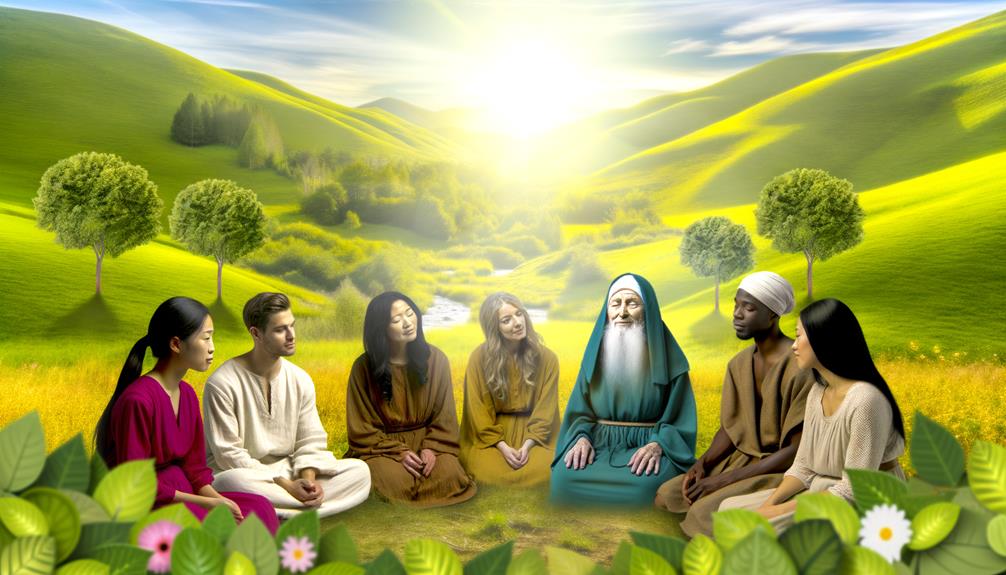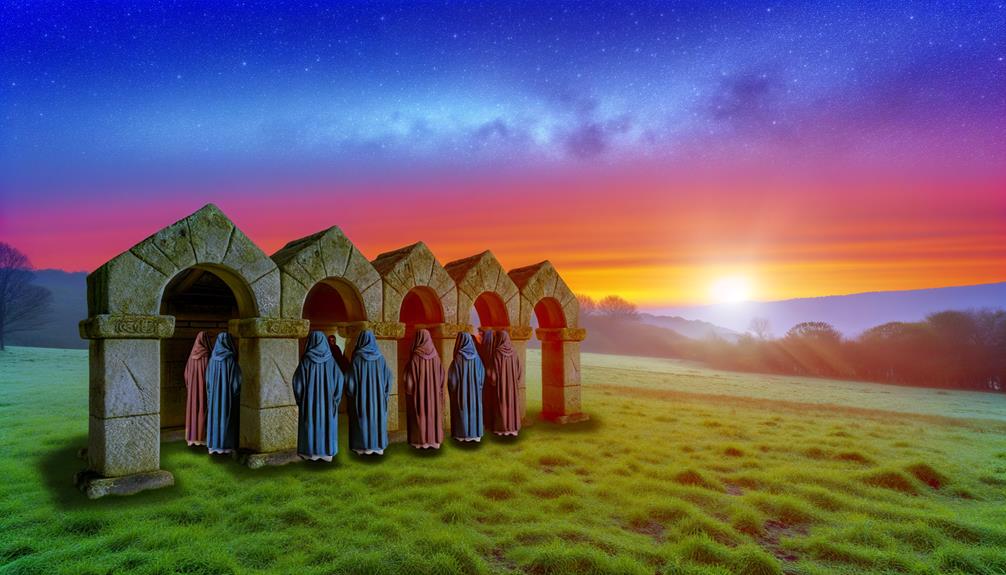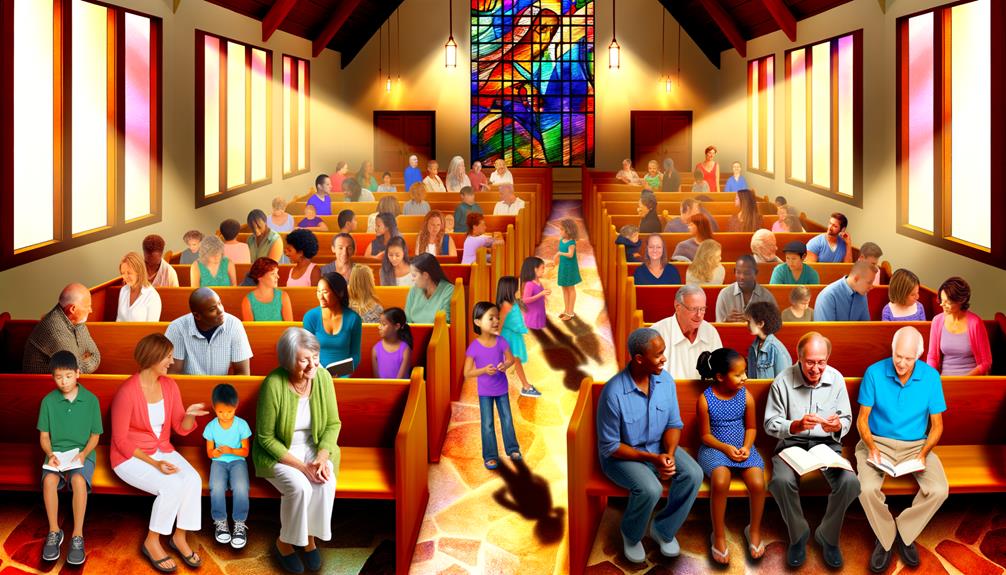Meet Meaning in the Bible: Divine Encounters
In the Bible, the term ‘meet’ encompasses significant divine-human encounters that profoundly shape faith narratives and communal identities. These meetings range from transformative spiritual experiences, like Moses at the burning bush, to covenantal encounters that establish foundational promises between God and humanity.
Prophetic meetings convey divine messages, guiding community directions, while destiny encounters align human actions with divine purposes, as seen in Saul’s conversion on the road to Damascus. Communal gatherings also play an essential role, fostering unity and spiritual growth among believers.
Each type of meeting underscores God’s dynamic engagement with humanity, inviting a deeper exploration of these sacred interactions.

Meaning of Meet in the Bible: Definitions, Context, and Spiritual Insights
| Aspect | Details |
|---|---|
| Word | Meet |
| Origin (Hebrew) | Qara (קָרָא) – to encounter, summon |
| Origin (Greek) | Hypantēsis (ὑπάντησις) – to go out to meet |
| Biblical Usage | Refers to divine appointments, human encounters, or fitting situations |
| Key Verses | Genesis 2:18 (“help meet”), Matthew 25:6 (“go out to meet him”) |
| Symbolism | Divine timing, relationship, readiness, unity |
| Spiritual Insight | Represents purposeful encounters—either with God, people, or destiny |
Divine Encounters

Divine encounters in the Bible serve as pivotal moments where human experience intersects with the transcendent, revealing profound theological insights and shaping the narrative of faith. These encounters often occur in the most unexpected places, highlighting the importance of both the spiritual highs and lows that define a believer’s journey. From the awe-inspiring revelations on mountains to the deep introspections found in valleys, the mountains and valleys in scripture illustrate the dynamic relationship between humanity and the divine. In these moments, individuals are transformed, and their faith is deepened, serving as a testament to the enduring power of God’s presence in every circumstance. These encounters often challenge individuals to wrestle with faith in scripture, prompting a deeper understanding of their beliefs and the divine. Through these transformative experiences, characters in the Bible reveal their vulnerabilities and doubts, highlighting the complexity of the human condition. Ultimately, these moments serve not only as turning points in their journeys but also as timeless lessons for readers grappling with their own spiritual quests. These encounters often compel individuals to confront their beliefs, leading them to seek deeper understanding and purpose in their lives. As they grapple with these divine revelations, many have sought meaning in scripture to navigate the complexities of their experiences. Ultimately, these transformative moments not only enhance personal faith but also contribute to the collective understanding of the divine narrative.
These encounters often occur at significant junctures, such as Abraham’s call in Genesis 12, where God’s promise initiates a covenantal relationship that defines Israelite identity.
Similarly, Moses’ encounter with the burning bush in Exodus 3 marks a transformative moment, equipping him to lead the Israelites out of bondage.
These episodes are not mere historical records but theological constructs that convey God’s immanence and providence.
They underscore a dynamic relationship between the divine and humanity, emphasizing themes of covenant, mission, and revelation, thereby enriching the biblical narrative with layers of spiritual meaning.
Meeting God Face to Face

In the biblical narrative, encounters with God often manifest in deeply transformative experiences that alter the course of individuals’ lives and, by extension, the trajectory of entire communities.
Key scriptural accounts, such as Moses’s encounter at the burning bush and Jacob’s wrestling with the divine, serve as paradigmatic examples of face-to-face encounters that redefine human understanding of the divine and themselves.
These moments are not merely historical records but are theological touchpoints that illustrate the profound impact of divine presence on human existence.
Divine Encounters in Scriptures
Throughout the Bible, numerous instances depict individuals experiencing profound encounters with God, often described regarding direct, face-to-face meetings. Such divine encounters are not merely physical interactions but are laden with deep theological significance. These moments often symbolize a transformative relationship, where the divine presence profoundly impacts the individual’s faith journey. One such reference is found in the concept of the ‘secret place in the Bible,’ a metaphor for intimate communion with God, emphasizing the necessity of solitude and reflection for spiritual growth. This sacred space allows believers to encounter God in a personal and profound way, deepening their understanding of His nature and will.
For example, in Exodus 33:11, Moses speaks to God ‘face to face, as one speaks to a friend,’ symbolizing an intimate communion that transcends ordinary human experience. Similarly, Jacob’s wrestling with God in Genesis 32:30 is a pivotal moment that transforms his identity.
These narratives emphasize the accessibility of divine presence, yet also highlight the awe and reverence that accompany such encounters. Theologically, these meetings underscore God’s immanence and personal engagement with humanity, inviting believers into a deeper, relational understanding of the divine.
Transformative Spiritual Experiences
Transformative spiritual experiences, particularly those described as meeting God face to face, serve as pivotal moments of profound change and theological insight within biblical narratives. Such encounters often signify a deepened relationship with the divine, leading to substantial shifts in personal vocation and communal identity.
For instance, Moses’ encounter at the burning bush and Jacob’s wrestling with God both illustrate moments where divine presence and human experience intersect, resulting in transformative revelations.
| Encounter | Biblical Figure | Result |
|---|---|---|
| Burning Bush | Moses | Leadership of Israel |
| Wrestle with God | Jacob | Name changed to Israel |
| Mount Sinai | Moses | Reception of the Ten Commandments |
| Damascus Road | Paul | Conversion and mission |
These experiences provide foundational theological themes of covenant, identity, and mission.
Covenant Meetings

Covenant meetings, as depicted in the Bible, serve as profound theological events that signify pivotal moments of divine-human interaction and the establishment of sacred agreements. These encounters often involve solemn ceremonies where God and humanity enter into binding commitments.
For instance, the covenant with Noah (Genesis 9) marks a divine promise never to flood the earth again, symbolized by the rainbow. Similarly, God’s covenant with Abraham (Genesis 15) promises numerous descendants and land, establishing a foundational relationship for Israel’s identity.
At Sinai, the Mosaic Covenant (Exodus 19-24) sets forth laws and ethical guidelines, emphasizing obedience and exclusive worship. Each covenant meeting is not merely a historical event but a theological cornerstone, underscoring the enduring nature of God’s promises and human responsibility.
Prophetic Meetings

Prophetic meetings in the Bible encapsulate moments of divine encounters where prophets receive and convey God’s messages.
These assemblies often serve as pivotal junctures in biblical narratives, revealing theological insights and guiding the community’s course.
Divine Encounters in Scripture
The Bible is replete with divine encounters where individuals are called to prophetic missions, each serving as essential junctures in the unfolding of God’s salvific plan. These encounters are characterized by direct communication from God, often through visions or voices, and serve to guide, correct, or forewarn His people. They underscore the profound relationship between the divine and the human, showcasing God’s sovereign will and the chosen individual’s obedience.
| Prophetic Figure | Encounter | Mission |
|---|---|---|
| Moses | Burning Bush | Deliver Israel from Egypt |
| Isaiah | Vision in the Temple | Proclaim judgment and hope |
| Jeremiah | God’s Voice | Warn Judah of impending exile |
| Ezekiel | Vision of God’s Glory | Prophesy restoration and new covenant |
These moments are pivotal, illustrating divine intervention in human history.
Prophets’ Divine Assemblies
In the context of biblical theology, divine assemblies among prophets serve as significant forums for communal discernment and the reception of collective revelation.
These gatherings, as seen in texts like 1 Kings 22 and Amos 3:7, highlight the collaborative nature of prophetic ministry. Prophets would convene to seek divine guidance, share visions, and confirm God’s will for the people.
Theologically, these assemblies underscore the communal aspect of divine communication, contrasting individualistic approaches. This collective dynamic reinforces the idea that revelation is not solely personal but is often mediated through a community of faith.
Such assemblies also provided checks and balances, ensuring that prophetic messages were aligned with divine truth, thereby safeguarding against false prophecies and subjective interpretations.
Destiny Encounters

Throughout biblical narratives, destiny encounters often serve as pivotal moments where divine purpose and human action intersect. These encounters, imbued with profound theological significance, reveal how God orchestrates events to fulfill His sovereign will.
For instance, Moses’ encounter with the burning bush (Exodus 3) marked a transformative moment, catalyzing the liberation of Israel from Egypt. Similarly, Saul’s experience on the road to Damascus (Acts 9) dramatically redirected his life, shaping him into the Apostle Paul and altering the course of early Christianity.
Such events are not mere coincidences but orchestrated by divine providence to align human actions with God’s redemptive plan. These moments underscore the dynamic interplay between divine sovereignty and human agency within the biblical framework.
Community Gatherings

Community gatherings in the Bible serve as essential settings where collective worship, instruction, and communal identity are cultivated, reflecting the integral role of fellowship within God’s covenantal relationship with His people.
Theologically, these assemblies are crucial for spiritual edification and communal accountability.
Contextually, gatherings such as the Israelites’ assembly at Mount Sinai (Exodus 19-20) or the early Christian communities (Acts 2:42-47) underscore the significance of shared experiences in faith formation.
These events facilitate a deeper understanding of divine teachings, strengthen communal bonds, and reinforce a collective identity rooted in divine purpose.
Biblically, the frequent reference to gatherings underscores their role as a microcosm of the divine-human relationship, serving both as a spiritual anchor and a reflection of God’s inclusive covenant.
Conclusion
Ironically, while modernity seeks tangible evidence for spiritual encounters, the biblical narrative elevates the abstract nature of ‘meeting.’
Whether through divine encounters, face-to-face dialogues with God, covenantal assemblies, prophetic revelations, or communal gatherings, the Bible presents ‘meetings’ as transformative events that shape destinies and communities.
This theological exploration underscores the profound irony: genuine understanding of ‘meeting’ in the biblical context transcends the physical, inviting believers into a deeper, intangible communion with the divine.






